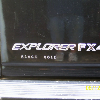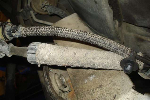Sorry, but I have to taker exception to the suggestion of reducing the air pressure in your tires in any onroad situation, ESPECIALLY on an Explorer. That works for rock crawlers and offroad guys who are trying to get traction on uneven surfaces, and almost requires the use of bead lockers to work. Onroad, reducing your tire pressure will cause a lot of sidewall flex as you drive, which generates a lot of internal heat in the tires and can damage them severely. Also, it reduces the stability of the tire tread's ability to follow steering inputs (remember the Firestone/Ford rollover fiasco). The idea of reducing tire pressures for traction is a leftover from the skinny tires with round cross sections of the 20's and 30's. It hasn't been valid since then, but the idea refuses to go away. Modern tires need a certain minimum tire pressure to be safe and work properly. Conservative driving trumps any other solution.










